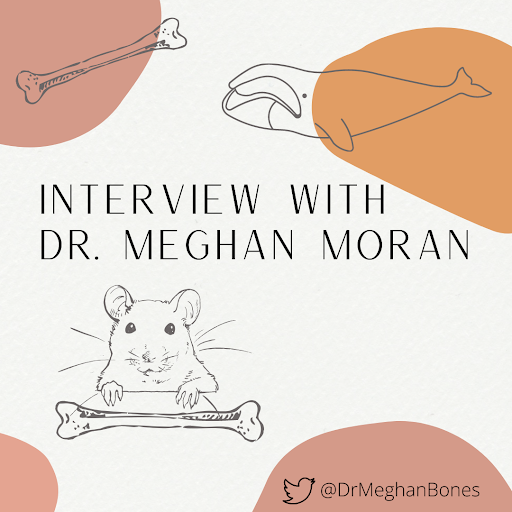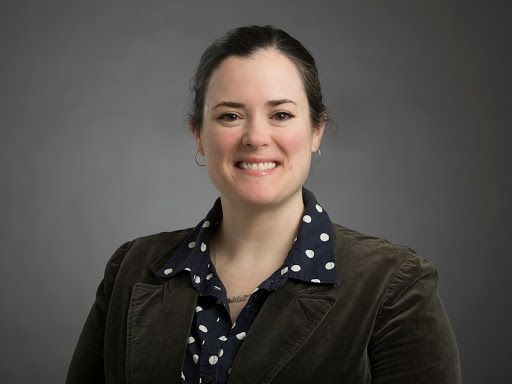Interview with Dr. Meghan Moran

By Laura Tran, C2ST Intern, Rush University
Dr. Meghan Moran, Ph.D., is an assistant professor in the Department of Cell & Molecular Medicine at Rush University Medical Center. She has always been interested in bones and how bones come together to make the skeleton. This passion led her to study the interactions between the gut, the gut microbiome, and bones in the context of failing joint implants. She made Halo Cures 40 Under 40 Chicago Scientists in 2019 and continues to conduct her innovative work in orthopedic research. I caught up with Dr. Moran to dive deeper into her story and give us more insight into her research journey.

C2ST: Tell me a bit about your background. In a previous conversation, we briefly talked about your interest in bones early on. How did that evolve into what you are doing now?
Dr. Meghan Moran: I started in academics as an anthropologist interested in the hominid fossil record and then after my MA, I worked as a bioarchaeologist here in IL. Then, I went back to school for my Ph.D. and I wanted to learn how to take a deeper look at the bone, so when an opportunity presented itself for me to transfer to a lab that used more cellular-based approaches to studying bone, I took it. This was a big turning point in my career. I learned basic lab skills like how to use a microscope, calculate concentrations, as well as looking at tissues under the microscope (histology), and staining tissues for proteins (immunohistochemistry). I had another big turning point in my career when I took a postdoc position at Rush, where my research made a translational turn and I’ve been on that path ever since.
C2ST: How did you get involved in your initial Ph.D. research?
MM: As I’ve moved through different areas of science, my interests have evolved and my research has evolved to land me where I am today. Once I moved on from anthropology, I branched out to comparative anatomy looking at the bones and teeth of different animals. During this time, I also gained experience in a cartilage research lab that grew islands of cartilage in the lab- they looked like little contact lenses. After this, my dissertation started to take shape. I focused on the patterns of growth plate fusion in cetaceans (whales, dolphins, and porpoises) compared to terrestrial mammals, like a mouse. I also studied the pattern and protein expression of ossification (cartilage changing to bone) in the intervertebral disc. This bone formation happens as part of the normal development of the sacrum in terrestrial mammals, but in some species of baleen whale (filter feeders), intervertebral fusion occurs between the 7 cervical vertebrae.
C2ST: Why cetaceans (e.g., whales, dolphins, and porpoises)?
MM: When I transferred out of anthropology, my new advisor was (and still is) a paleontologist and he studied whale evolution. 50 million years ago, the ancestors of whales walked on land and later they moved into the water. In his lab, we were required to have a chapter of our dissertation on developmental biology, one on molecular biology, and one on paleontology. It was super integrated and allowed trainees to have a wide exposure to different sciences. This is the reason I have published papers on different topics, like dolphin skull development, bone regeneration in mice, and the gut-joint axis.
C2ST: Did you always want to work with them?
MM: Nope. Studying whales never crossed my mind! It was a random alignment of the stars when I transferred labs. It ended up being one of the most fascinating and coolest things I’ve ever done.
C2ST: What was the most memorable experience from your Ph.D. work?
MM: The trips I took to Utqiaġvik (formerly known as Barrow), AK. There I worked with the Department of Fish and Wildlife to study bowhead whales. It’s a bush town meaning there are no roads out of town, you fly in and out on a small plane. It is the northernmost city in the US, located 300 miles north of the Arctic Circle. Those trips impacted me a lot. It was really an amazing place- tundra and the Arctic Ocean as far as you can see.
C2ST: That’s quite an adventure! What brought you to Chicago?
MM: I wanted to come back to Chicago after graduation. This is my hometown, I grew up in the suburbs and my boyfriend (now husband) and family were here. I heard about Rick Sumner’s lab and the bone research going on at Rush through my Dad. One of his colleagues from Loyola had a daughter who was a postdoc in the Sumner lab (Margaret McNulty, @DrMAMcNulty). So, before I defended my dissertation, I researched Sumner and his work and approached him at the 2011 American Association of Anatomists (AAA) Regional Meeting to meet him and discuss a potential postdoc. He was very nice, but at that time he didn’t have space in the lab for another postdoc, so he turned me down. That was a big disappointment, but a few months later Margaret left for a faculty position and Rick called me. I got the job! I overlapped with Margaret for only 3 days and was promptly thrown into the deep end of continuing the experiments she was working on in the lab. It was sort of terrifying for a newly minted Ph.D. who studied whales, but it all worked out.
C2ST: What a transition! The size difference between whale bones and rodent bones alone is daunting. What were the initial challenges of this transition in your research?
MM: Powering an experiment! I had no idea what that meant! Basically, power analysis will calculate and tell us how big our sample size needs to be, to show an actual difference as opposed to chance. I had never designed an experiment with power in mind before arriving at Rush. Now, that’s the second thing I do- 1- think of an experimental idea, and 2- test power.
C2ST: What is your current research focus?
MM: Today I’d label myself as an orthopedic researcher and I study bone regeneration after injury and orthopedic implant stability (* think hip and knee joint replacements when I say implants). Now I’m focused on understanding how the gut is affected by inflammatory changes in the bone and joints and how the gut affects the bone and joints- I think it is a type of feedback loop or cycle. This communication is called the gut-bone and gut-joint axes. Recently, I showed that inflammatory changes in the knee joint and implant loosening due to bone loss change the gut microbiome. Many researchers have shown that changing the gut using antibiotics, dietary supplements or high fiber diets alter bone. We still don’t know how this is happening. What is it in the body that is linking these two organ systems?
C2ST: It is amazing to think about the interplay between different organ systems. There is still so much more to unravel! How will your findings impact human health?
MM: The translational goal of my research is to decrease joint inflammation and the need for revision surgery. Joint revision surgery occurs when an orthopedic implant has failed and needs to be replaced with a new implant. I want to help keep joints healthy- whether that is your cartilage and bone, or replacement parts made from metals and plastics. And I think the gut holds some very interesting options for how this can happen.
C2ST: Is there anything else that you would like to add?
MM: My advice to up-and-coming Ph.D. candidates is: don’t give up! My Dad would tell me two things; 1) if 50% of your experiments work, then you’re doing pretty well and 2) if it were easy, it’d already be done. So, don’t let failure prevent you from trying again! Science is a tough job and if you are interested in what you’re studying and happy doing science, that goes a long way.
Thank you so much for taking the time to speak with us about your journey, Dr. Moran! One thing is for certain, you never quite know where science and research will take you. Working with whale bones and traveling to the northernmost city in the US is incredible! Then, transitioning to rodent bones is something akin to culture shock based on their sheer size difference. You are absolutely right- science is a tough gig, but it is a rewarding process!
Keep up with Dr. Meghan Moran and connect with her on Twitter: @DrMeghanBones